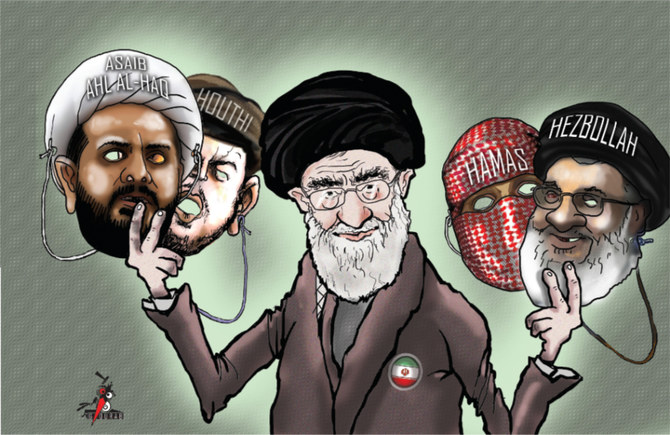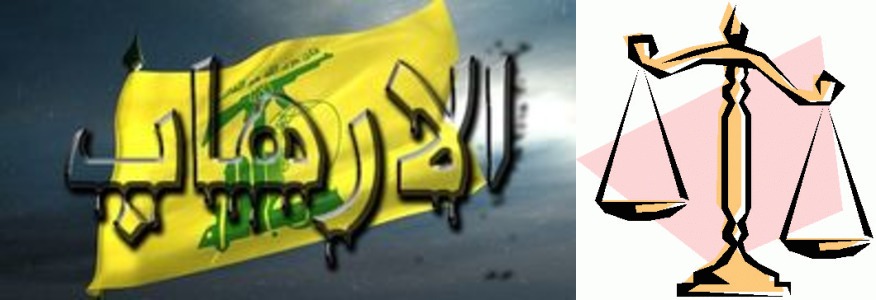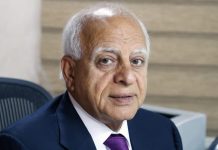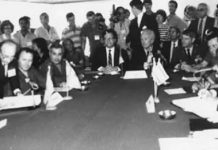داخل النظام الإيراني (الجزء الأول): تزايد الانقسامات وضعف الروح المعنوية في “الحرس الثوري” الإيراني؟
پاتريك كلاوسون/معهد واشنطن/29 آذار/2023
Inside Iran’s Regime (Part 1): Growing Fissures and Poor Morale in the IRGC?
Patrick Clawson/The Washington Institute/March 29/2023
A recently leaked document—if genuine—may indicate substantial internal skepticism toward the regime’s handling of the current domestic crisis, and perhaps even pressure for limited reforms.
Last week, media outlets Iran International and IranWire claimed they had been given an eye-opening forty-four-page document detailing frustrations and criticisms among senior tiers of the Islamic Republic’s military leadership. According to their reports, the document consists of notes from a January 3 meeting between commanders in the Islamic Revolutionary Guard Corps (IRGC) and Supreme Leader Ali Khamenei. Person-by-person remarks are detailed from forty-five officials: six clerics, three major-generals, twenty-three brigadier-generals, five sardars (a generic term for generals of all types), and eight colonels. At the end, a report is given on Khamenei’s forty minutes’ worth of remarks.
If the document is authentic, it offers a much more negative picture of the regime’s stability and the state of the IRGC than is customarily found in commentary inside or outside Iran. This PolicyWatch—the first in a multipart series—focuses on the document’s provenance and general policy implications
Fake or Real?
Caution is in order when evaluating the document, since there are compelling arguments both for and against its authenticity. Such a product can be easily fabricated these days, and the background of the two organizations that published it may raise authenticity questions as well. This is presumably why the document has not been covered much by other media organizations—indeed, no major Western newspaper appears to have picked up the story.
The first short report about the January 3 meeting, posted on Twitter the day after it took place by the Britain-based lawyer and human rights activist Kaveh Moussavi, was widely dismissed on social media and drew little attention from analysts. Then came the Iran International and IranWire stories, along with the full document. Both of these outlets are relentless critics of the Iranian regime—so much so that Tehran reportedly made toning down the first outlet’s coverage a central demand in its recent normalization negotiations with Saudi Arabia (Iran International is based in London but funded by Saudi individuals). Partly because of this reputation, Iran International evidently receives a great many items claiming to be leaks of sensitive information.
IranWire was launched in 2013 by award-winning Iranian-Canadian journalist Maziar Bahari after his release from Evin Prison. It works with many prominent Iranian journalists and has much more material in Persian than English. The outlet describes itself as having “a strong focus on documenting human rights abuses in Iran” while largely avoiding “macro issues such as the nuclear program, which are abundantly covered by bigger media organizations.” It also has an ongoing partnership with the American news site Daily Beast.
Despite the question marks about the document’s provenance, however, the regime appears to have offered no official repudiation of the purported leak—a striking contrast to its normal practice of loudly denouncing unfavorable reports, even ones that are almost certainly accurate. There is also strong reason to believe that the January 3 meeting occurred, since considerable reporting emerged about IRGC commanders gathering with Khamenei during that week’s commemorations of the death of IRGC-Qods Force general Qasem Soleimani.
Fissures and Poor Morale in the IRGC?
Like any organization composed of 600,000 people (including affiliates such as the Basij militia), the IRGC no doubt has complex internal politics in which senior officials hold differences of opinion (even bitterly so) and dissatisfied elements express disrespect for their superiors. These traits seem especially likely in an outfit with as many different components as the IRGC, which has separate, large, and powerful branches dedicated to missions as diverse as developing drones and missiles, supporting foreign terrorists and insurgencies, engaging in air and naval operations, running lucrative businesses, hunting foreign agents inside Iran, and orchestrating mass repression of the citizenry. In that sense, the serious differences voiced in the forty-four-page document should come as no surprise.
Still, it is striking to read how extensive and strongly held these differences appear to be. For instance, some of the speakers purportedly summarized in the document strongly defend Khamenei’s son Mojtaba for his recent interventions in IRGC affairs, while others bluntly criticize him. The criticism comes mostly from officers responsible for the provinces; the support mostly from those based in Tehran.
The document also characterizes military morale as poor. Abdollah Haji Sadeqi, Khamenei’s representative in the IRGC, is quoted as stating, “Based on our reports, it appears that the IRGC forces are not in the same situation as last year, particularly with respect to their morale, as there has been a decline.” Mahmoud Mohammadi Shahroudi, commander of the Basij seminary students, purportedly stated that “around 5,000 members have left” in recent months, noting, “I believe that the recent issues of abandoning religious clothing, as well as conflicting beliefs among students and clerics in the last two months, may have been a surprise.” Mohsen Karimi, commander of the IRGC’s Ruhollah Brigade stationed near Tehran, mentioned that some soldiers had been arrested after holding protests; he also described the situation on the ground around the city of Arak southwest of the capital, noting that belief in the Islamic Republic’s system had declined by half. Hassan Hassanzadeh, head of the IRGC’s Mohammad Rasulullah Corps of Greater Tehran, noted that some soldiers had been found to be sympathizing with people on the street during protests rather than carrying out orders. And Ehsan Khorshidi, a deputy IRGC commander in Alborz province, stated, “Recently we have witnessed instances of disruption and aid by armed forces toward civilians.” He also described soldiers stealing from a storage depot to distribute goods to civilians.
No Clear Voice Commanding Universal Respect
One of the most remarkable aspects of the comments reported in the leaked document is how little respect and support they show for the regime and IRGC leadership. Numerous speakers lash out at President Ebrahim Raisi and his team for incompetence and mismanagement, but criticizing elected governments is hardly unusual among regime and military officials. What is surprising is how few of them made explicit statements supporting the revolution’s general direction or Khamenei’s leadership.
To be sure, some of the quoted officials do stand up for the Supreme Leader. For example, Awaz Shahabifar, military advisor to the Qods Force in Iraq, purportedly complains, “These conversations show that you object to the leadership. We were supposed to stand by the leader’s side in difficult times.” Yet few others pick up this theme, and there is no sense in the document that the speakers couched their candid criticism in the context of general support for the leadership or the revolution’s ideology.
Of course, this could be a product of how the remarks were reported. Perhaps the rapporteur found such statements so unexceptional as to not include them. Yet it could also be the case that no figure in the regime still commands the same level of respect and unquestioning loyalty seen in the past.
Policy Implications
Even if the leaked document proves to be genuine, it is still just a description of a meeting rather than a complete, verbatim transcript, and may therefore reflect what the rapporteur or leaker wanted to portray as much as what was actually expressed. Again, however, it is quite noteworthy that the regime has not rushed to insist that all IRGC commanders hold the same positive views, or that reports of internal fissures are fake or exaggerated. This suggests that at least some regime figures are willing to live with—or even wanted to publicize—reports that powerful voices inside the system are calling for substantial change.
The main takeaway from the document is that foreign policymakers and analysts should be cautious about any assessments that the Islamic Republic’s control over Iranian society is rock-solid, or that IRGC commanders are ready, able, and willing to do whatever it takes to keep the regime in power while it continues to eschew major concessions to public opinion. Perhaps the internal voices for reform that gives people more freedom (even if not more voice over government decisions) are stronger than believed. The general rule with authoritarian regimes is that they look like they cannot be challenged—right up until the situation suddenly changes and they look like they cannot persist. The purportedly leaked document suggests that one cannot be completely sure where the Islamic Republic ranks on that scale.
*Patrick Clawson is the Morningstar Senior Fellow and director of research at The Washington Institute.
داخل النظام الإيراني (الجزء الأول): تزايد الانقسامات وضعف الروح المعنوية في “الحرس الثوري” الإيراني؟
پاتريك كلاوسون/معهد واشنطن/29 آذار/2023
قد تشير الوثيقة التي تم تسريبها مؤخراً – إذا كانت حقيقية – إلى وجود شك داخلي كبير تجاه تعامل النظام الإيراني مع الأزمة المحلية الحالية، وربما حتى قيام حملة ضغط من أجل إجراء إصلاحات محدودة.
في الأسبوع الماضي، ادّعت الوسيلتان الإعلاميتان “إيران إنترناشيونال” و”إيران واير” أنهما تلقتا وثيقة لافتة تضم أربع وأربعين صفحة توضح بالتفصيل الإحباط والانتقادات في الصفوف العليا للقيادة العسكرية في الجمهورية الإسلامية. ووفقاً لتقريرَيْهما، تضم الوثيقة ملاحظات من اجتماع عُقد في 3 كانون الثاني/يناير بين قادة في “الحرس الثوري الإسلامي” الإيراني والمرشد الأعلى علي خامنئي، وهي ملاحظات فردية مفصلة أدلى بها خمسة وأربعون مسؤولاً، هم: ستة رجال دين، وثلاثة ألوية في الجيش، وثلاثة وعشرون عميداً، وخمسة سردارات (مصطلح عام للجنرالات من جميع الفئات)، وثمانية عقداء. وفي النهاية، تم تقديم تقرير عن ملاحظات خامنئي التي دامت أربعين دقيقة.
وإذا كانت الوثيقة أصلية، فهي تعطي صورة سلبية عن استقرار النظام وحالة “الحرس الثوري” الإيراني أكثر بكثير من تلك التي تعكسها عادةً التعليقات داخل إيران أو خارجها. ويركز هذا المرصد السياسي – الذي هو الأول في سلسلة متعددة الأجزاء – على مصدر الوثيقة وتداعياتها على السياسة العامة.
وهمية أم حقيقية؟
يجب توخي الحذر عند تقييم الوثيقة، نظراً لوجود حجج مقنعة تؤيد صحتها أو تدحضها. ويمكن تلفيق مثل هذا المنتج بسهولة هذه الأيام، وقد تثير خلفية المنظمتين اللتين نشرتاه تساؤلات حول مصداقيته أيضاً. ومن المفترض أن هذا هو سبب عدم تغطية الوثيقة كثيراً من قبل المؤسسات الإعلامية الأخرى – وفي الواقع، لا يبدو أن أي صحيفة غربية كبرى قد التقطت الخبر.
وتجاهلت وسائل التواصل الاجتماعي على نطاق واسع التقرير القصير الأول عن اجتماع 3 كانون الثاني/يناير، الذي نشره المحامي والناشط الحقوقي المقيم في بريطانيا، كاوه موسوي، على تويتر في اليوم الذي أعقب عقد الاجتماع، كما لفت التقرير القليل من الاهتمام من قِبل المحللين. ثم جاءت قصص “إيران إنترناشيونال” و”إيران واير”، بالإضافة إلى الوثيقة الكاملة. وتُعد كل من هاتين الوسيلتين الإعلاميتين ناقدة بلا هوادة للنظام الإيراني – لدرجة أن طهران جعلت التخفيف من تغطية وسيلة الإعلام الأولى مطلباً مركزياً في مفاوضات التطبيع الأخيرة مع المملكة العربية السعودية (يقع مقر “إيران إنترناشيونال” في لندن ولكنها مموّلة من قبل أفراد سعوديين). وبسبب هذه السمعة جزئياً، تتلقى “إيران إنترناشيونال” بطبيعة الحال عدداً كبيراً من الأخبار التي يُزعم أنها تسريبات لمعلومات حساسة.
تأسست “إيران واير” في عام 2013 على يد الصحفي الإيراني الكندي الحائز على جوائز “مازيار بهاري” بعد إطلاق سراحه من “سجن إيفين”. وتعمل هذه الوسيلة الإعلامية مع الكثير من الصحفيين الإيرانيين البارزين ولديها أخبار باللغة الفارسية أكثر بكثير من الإنكليزية. وتصف وسيلة الإعلام نفسها بأنها “تركز بقوة على توثيق انتهاكات حقوق الإنسان في إيران” بينما تتجنب إلى حد كبير “القضايا الكلية مثل البرنامج النووي، والتي تغطيها المؤسسات الإعلامية الكبرى بكثرة”. كما لديها شراكة مستمرة مع موقع الأخبار الأمريكي “ديلي بيست”.
وعلى الرغم من علامات الاستفهام حول مصدر الوثيقة، يبدو أن النظام لم يعرض أي تنصل رسمي من التسريب المزعوم – وهو تناقض صارخ مع ممارسته العادية المتمثلة في التنديد بقوة بالتقارير غير المواتية، حتى تلك التي تكاد تكون دقيقة بشكل شبه مؤكد. وهناك أيضاً سبب قوي للاعتقاد بأن اجتماع 3 كانون الثاني/يناير قد حدث، حيث ظهرت تقارير كثيرة عن تجمع قادة “الحرس الثوري” الإيراني مع خامنئي خلال ذلك الأسبوع لإحياء ذكرى مقتل جنرال “فيلق القدس” التابع لـ “الحرس الثوري” قاسم سليماني.
انشقاقات وضعف الروح المعنوية داخل “الحرس الثوري” الإيراني؟
على غرار أي منظمة تضم600,000 شخص (بمن فيهم المنتسبين مثل ميليشيا “الباسيج”)، لا شك أن “الحرس الثوري” يتّبع سياسات داخلية معقدة يختلف فيها كبار المسؤولين في الرأي (حتى بمرارة) وتُعبّر في إطارها العناصر الممتعضة عن عدم احترامها لرؤسائها. وتبدو هذه السمات مرجحة بشكل خاص في جماعة تضم الكثير من المكونات المختلفة مثل “الحرس الثوري”، الذي لديه فروع منفصلة وكبيرة وقوية مخصصة لمهام متنوعة مثل تطوير الطائرات بدون طيار والصواريخ، ودعم الإرهابيين الأجانب وحركات التمرد، والمشاركة في العمليات الجوية والبحرية، وإدارة الأعمال المربحة، ومطاردة العملاء الأجانب داخل إيران، وتنظيم القمع الجماعي للمواطنين. وبهذا المعنى، فإن التباين الكبير في وجهات النظر التي تم الإعراب عنها في الوثيقة المكونة من أربع وأربعين صفحة لا ينبغي أن تكون مفاجأة.
ومع ذلك، من المدهش الإطلاع على مدى اتساع هذه الاختلافات وحدة التشبث بها. على سبيل المثال، يدافع بعض المتحدثين الذين تم إيجاز ملاحظاتهم كما يُزعم في الوثيقة، وبشدة عن مجتبى، نجل خامنئي، بسبب تدخلاته الأخيرة في شؤون “الحرس الثوري” الإيراني، بينما ينتقده آخرون بشدة. وتأتي الانتقادات في الغالب من الضباط المسؤولين عن المحافظات؛ بينما يأتي معظم الدعم من أولئك المتواجدين في طهران.
كما تشير الوثيقة إلى ضعف المعنويات العسكرية. ونُقل عن عبد الله حاجي صادقي، ممثل خامنئي في “الحرس الثوري”، قوله: “بناءً على تقاريرنا، يبدو أن قوات “الحرس الثوري” ليست في الوضع ذاته الذي كانت عليه في العام الماضي، لا سيما فيما يتعلق بمعنوياتها، بما أنها شهدت تراجعاً”. وأفاد محمود محمدي شهرودي، قائد طلاب الحوزة في “الباسيج”، كما زُعم، أن “حوالي 5000 عضو قد غادروا” في الأشهر الأخيرة، مضيفاً: “أعتقد أن القضايا الأخيرة المتعلقة بالتخلي عن الزي الديني، وكذلك المعتقدات المتضاربة بين الطلاب ورجال الدين في الشهرين الماضيين، ربما كانت مفاجئة”. وذَكر محسن كريمي، قائد “لواء روح الله” التابع للحرس الثوري الإيراني المتمركز بالقرب من طهران، أن بعض الجنود قد اعتُقلوا بعد تنظيمهم احتجاجات. كما وصف الوضع على أرض الواقع حول مدينة أراك جنوب غربي العاصمة، مشيراً إلى تراجع الإيمان بنظام الجمهورية الإسلامية بمقدار النصف. وأشار حسن حسن زاده، قائد “فيلق محمد رسول الله” التابع لـ “الحرس الثوري” في طهران الكبرى، إلى أنه تبين أن بعض الجنود تعاطفوا مع الناس في الشارع أثناء الاحتجاجات بدلاً من تنفيذ الأوامر. وصرح إحسان خورشيدي، نائب قائد “الحرس الثوري” في محافظة البرز: “لقد شهدنا مؤخراً حالات عرقلة ومساعدة من قبل القوات المسلحة لصالح المدنيين”. كما وصف جنود يسرقون من مستودع لتوزيع البضائع على المدنيين.
عدم وجود صوت واضح يحظى باحترام عالمي
يتمثل أحد أبرز جوانب التعليقات الواردة في الوثيقة المسربة في قلة الاحترام والدعم الذي تظهره (الصفوف العليا للقيادة العسكرية) تجاه النظام وقيادة “الحرس الثوري”. فقد انتقد الكثير من المتحدثين الرئيس إبراهيم رئيسي وفريقه على خلفية عدم الكفاءة وسوء الإدارة، لكن انتقاد الحكومات المنتخبة ليس بالأمر المعتاد بين مسؤولي النظام والعسكريين. والمثير للدهشة هو أن قلة منهم أدلوا بتصريحات صريحة تدعم الاتجاه العام للثورة أو قيادة خامنئي.
ويقيناً، أن بعض المسؤولين من أصحاب التعليقات يدافعون عن المرشد الأعلى. على سبيل المثال، يُزعم أن المستشار العسكري لـ “فيلق القدس” في العراق، عواز شهابيفر، يشكو مما يلي: “تُظهر هذه المحادثات أنكم تعترضون على القيادة. كان من المفترض أن نقف إلى جانب الزعيم في الأوقات الصعبة”. ولكن قلة يلحظون هذا الموضوع، ولا إشارة في الوثيقة إلى أن المتحدثين صاغوا انتقاداتهم الصريحة في سياق الدعم العام للقيادة أو أيديولوجية الثورة.
وبالطبع، قد ينتج ذلك من كيفية الإبلاغ عن الملاحظات. ربما وجد المقرر أن مثل هذه التصريحات غير استثنائية لدرجة أنه لم يقم بإدراجها. ومع ذلك، يمكن أن يكون هذا هو الحال بأنه لا توجد شخصية في النظام لا تزال تتمتع بنفس المستوى من الاحترام والولاء المطلق الذي شوهد في الماضي.
التداعيات السياسية
حتى إذا ثبت أن الوثيقة المسربة حقيقية، فهي لا تزال مجرد وصف للاجتماع وليست نسخة حرفية كاملة عما جرى فيه، وبالتالي ربما قد تعكس ما أراد المقرر أو المسرب إظهاره بقدر ما تم التعبير عنه أساساً. ومع ذلك، تجدر الإشارة مجدداً إلى أن النظام لم يسارع إلى الإصرار على أن جميع قادة “الحرس الثوري” يتشاركون الآراء الإيجابية ذاتها، أو أن التقارير عن الانقسامات الداخلية وهمية أو مبالغ فيها. ويشير ذلك إلى أن بعض رموز النظام على الأقل على استعداد للتعايش مع التقارير التي تفيد بأن الأصوات القوية داخل النظام تطالب بتغيير جوهري، أو حتى أرادت الإعلان عن هذه التقارير.
وتتمثل الخلاصة الرئيسية من الوثيقة بأن على صانعي السياسات والمحللين الأجانب أن يكونوا حذرين بشأن أي تقييمات مفادها أن سيطرة الجمهورية الإسلامية على المجتمع الإيراني محكمة، أو أن قادة “الحرس الثوري” الإيراني مستعدون للقيام بكل ما يلزم وقادرون وراغبون على القيام بذلك، لإبقاء النظام في السلطة بينما يستمر النظام في تجنب التنازلات الكبرى للرأي العام. إن الأصوات الداخلية المؤيدة للإصلاح التي تمنح المواطنين المزيد من الحرية (حتى وإن لم يكن لها صوتاً أكبر في قرارات الحكومة) ربما تكون أقوى مما يُعتقد. والقاعدة العامة للأنظمة الاستبدادية هي أنها تبدو وكأنه لا يمكن تحدّيها – إلى أن يتغير الوضع فجأة ويبدو أنها لا تستطيع الاستمرار (في سياستها). وتشير الوثيقة التي يُزعم أنها مسربة إلى أنه لا يمكن معرفة ترتيب الجمهورية الإسلامية على هذا المقياس بشكل مؤكد.
پاتريك كلاوسون هو “زميل مورنينغستار” الأقدم ومدير الأبحاث في معهد واشنطن.





















